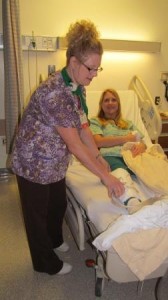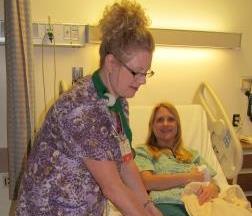
CLEARFIELD – During any hospital stay, a patient has an increased risk of developing a blood clot in an arm or leg that may break off and travel to the lungs, a potentially life-threatening complication.
“Blood clot risk is increased by factors such as immobility and recent surgery, but the condition is preventable. All patients admitted to the hospital should be assessed to establish if they are at risk of developing a blood clot so they can receive preventive treatment,” stated Kate Baumgratz, RN, director of the medical/surgical nursing floors.
Three years ago, the Performance Improvement Committee at Clearfield Hospital recognized weaknesses in the process at the hospital, and embarked on a patient safety initiative.
Baumgratz explained that while there were guidelines in place to assess blood clot risk when the project began, the rate of compliance for risk assessment, administration of blood-thinning medication, use of special stockings and documentation was not acceptable to the Performance Improvement Committee.
“Our outcomes for blood clot prevention were similar to many other hospitals’ outcomes at the time, but we didn’t use that as an excuse to keep the status quo. We needed to do better. Our staff needed to be more engaged and improve its level of performance,” Baumgratz said.
Physicians, nurses and support personnel made a strong commitment to the project, and reworked the process to ensure compliance to best practice standards.
Risk assessment is now done on every patient at the time of admission. Intake personnel look for risk factors such as immobility, history of blood clots, surgery, trauma, certain medical conditions such as heart disease, and obesity.
If deemed necessary, blood-thinning medication is administered within 24 hours. Support hose and compression devices are also used, and patients are encouraged to walk for short intervals to improve circulation. Documentation has been made easier thanks to the use of the hospital’s Electronic Health Records system.
Today, Clearfield Hospital compliance rates are between 98 and 100 percent for all standards.
Though hospital staff members have made great strides, their work is not done yet, according to Baumgratz.
“We will continue to make improvements until we are satisfied with compliance in all standards. As we move forward, we plan to expand patient and family engagement through education and identify other methods to further improve our performance,” she said.
Clearfield Hospital, an affiliate of Penn Highlands Healthcare, was recently recognized by Quality Insights of Pennsylvania, a not-for-profit health care quality improvement company, for the staff’s work on this project. Baumgratz and Catherine Civiello, PhD, director of quality, were also asked to give a presentation about the project’s success during Highmark’s 2012 Best Practices Forum.
“The collaboration and growth of the team was extremely rewarding in both the achievement of higher quality of care for our patients, and development of the camaraderie and commitment displayed by staff members,” stated Civiello.
